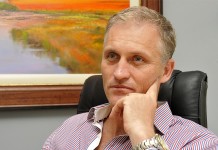
[miningmx] — THE malaise in the platinum group metal (PGM) sector, as Aquarius
Platinum CEO Stuart Murray recently described market conditions, has had a greater
effect on the company’s share price than the global economic crisis.
That’s quite something to digest and hammers home the point that Aquarius
Platinum’s management is facing no sterner test to its resolve than now. Can it
survive?
Yes, say analysts, but cash flow is the watch phrase. There was an 85% decline in
operating cash flow to $26m for Aquarius in its full-year ended June and a free cash
burn of $94m. All in all, that’s a cash swing of $148m, leaving cash and equivalents
at $180m. Murray says that’s enough to sustain the mines still in operation in the
current financial year (two mines, Everest and Marikana have been mothballed).
However, Aquarius Platinum’s cash reserves are not enough if the company is to
make good on a critical $150m (R1.2bn) acquisition from neighbour Northam
Platinum for a property called Booysendal South. Murray says that the company is
looking at alternative funding plans ahead of expectations that the acquisition
receives Government approval by the deadline of 31 March 2013 (after which, one
supposes, Aquarius could back out of the deal if it wanted).
Bank debt is one thing, but analysts also say a rights issue is not out of the
question. But can Aquarius afford that funding route given the parlous nature of its
company valuation?
Shares in Aquarius Platinum have fallen about 77% this year, and some 89% since
September 2011, which was the last time platinum traded at around $1,900/oz
before embarking on a downward trajectory of some 25% to current levels of
$1,500/oz.
Not even during the global financial crisis were shares in Aquarius hit as hard (84%
lower from about July 2008). Funding Booysendal South through shares would result
in issuing half the company’s value. It’s very dilutive.
Incidentally, if current PGM basket prices were to persist, Aquarius’s balance sheet
would show 40% gearing by its 2015 financial year, in excess of the 37% gearing
since the financial crisis – another indication of just how tough current conditions
really are.
As a result, Macquarie Research asked whether Aquarius and Northam would
consider renegotiating the transaction, which is why, perhaps, Northam has set
about a R2bn corporate issue, a new round of financing it announced on 3 August.
Primarily to fund the balance of the R4bn Booysendal mine, it nonetheless provides
balance-sheet flexibility to withstand a renegotiation with Aquarius Platinum.
From Aquarius’s point of view, however, can it afford not to do the acquisition of
Booysendal South? Booysendal South enables the currently mothballed Everest to
extend production – by some 3.5m oz in total – to 30 years from its current eight-
year life. As such, it will become one of the few assets owned by Aquarius Platinum,
outside of Mimosa Platinum Mines, to have a significant life extension.
In the meantime, it’s expected that Anglo American Platinum (Amplats) will take a
wait-and-see approach on Aquarius’s plans to move to an owner-operator model on
its remaining operating asset of significance, the Kroondal mine, which is slated to
produce 210, 000 oz in the current financial year.
So far, Amplats has, in consultation with Aquarius Platinum, mothballed two mines
that they share in joint venture.
Murray took offence at suggestions that Amplats would simply shut Kroondal as it
sought to remove unprofitable ounces from its books. “There is a 50:50 JV and we
have a say in it,’ said Murray in response to questions following the year-end results
presentation two week ago. “If you wanted to step out of that you would be acting
unilaterally,’ he added.
Ultimately, it’s what happens in the PGM market that is all important.
“Europe seems to be muddling through,’ said Murray of its role in demand for
autocatalysts in diesel cars, which platinum supplies. “This would dictate further
downsizing at Kroondal. But we will see for the next six months,’ he added. “We’re
in this for the long haul and we have to get through this unpleasant price climate.
We have shaped the business accordingly.’
– The article was originally published in Finweek.











